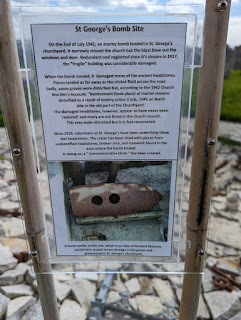I've moved on and am now in Dorset. I was meant to be doing what I did today tomorrow... don't ask!
First stop ?
St George's, Reforne, Portland
When I first visited MANY years ago it had odd opening hours but now it is proudly open from 10 daily.
It was built between 1754 and 1766 of Portland Stone (appropriately) and the tower is reminiscent of St Pauls Cathedral. There are pews on both side of the pulpits and those close to the altar have their backs to the altar! The church was closed in 1914 and fell into disrepair but the friends of St George church were able to restore it and it was one of the first 4 vested in the excellent Churches Conservation Trust in 1971.
The churchyard is amazing and the graves of fallen servicemen have been marked.
There are services twice a year on St Georges and Christmas Day.
Portland Castle is an artillery fort constructed by Henry VIII on the Isle of Portland, Dorset, between 1539 and 1541. It formed part of the King's Device programme to protect against invasion from France and the Holy Roman Empire.
It was besieged twice during the civil war finally falling to parliament in 1646.
It continued to be used as a military fort to the end of the Napoleonic war in 1815.
The castle was used as officer accommodation during WWII.
Oh and a nice friendly tea room. Good cheese ploughman :)
Jordan Hill Roman Temple is the remains of a Romano-Celtic temple which English Heritage says was probably built during the 4th Century AD. We're meant to CE now aren't we ? I'm old ;)
Stolen from the EXCELLENT English Heritage website.
The Jordan Hill site belongs to the end of the period of Roman occupation, when much of the economic structure was beginning to fragment, bringing changes to the social structure as well. It was apparently a small temple of a type common in Roman Britain: symmetrical in plan, with a central sanctuary or cella rising above a low columned portico which surrounded it on all four sides.
The temple was excavated in the 19th century and again in 1931, when the bases of four of the portico columns were located. The capital (head) and base of a fifth column were found loose near the north wall of the cella, and these can be seen in Dorchester Museum. Archaeologists found a well-like pit beneath the south-east corner of the sanctuary wall, about 4 metres (13 feet) deep and carefully lined with old roofing slabs. The pit contained 16 layers of ash and charcoal, alternating with layers of roofing slabs: between each of these were the bones of a bird and a small coin. At the bottom was a stone cist containing two urns, a sword and a spearhead. One of the coins dated from the reign of the Emperor Theodosius I (AD 379–95). Pits like this, used for ritual offerings, are a well-known feature of prehistoric Celtic religious sites throughout Europe, and suggest that many of the old pagan cults survived within the Roman Empire under a new guise, even after Christianity had become the official religion. Temples of this kind are known as Romano-Celtic because they appear to show a fusion of Celtic and classical religions.
I checked into my hotel... I was a bit early.
I wandered to the nearby river and wandered. It was a pretty walk.
I was surprised to find myself close to St Michaels Stinsford.
Thomas Hardy was baptised here and his heart is buried in the churchyard. Stinsford is the original 'Mellstock' of Hardy's novels Under the Greenwood Tree and Jude the Obscure.
I wandered back to the hotel and well....




























































































2 comments:
A full day Pete - love all the photos and both the churches. Roman temple looks interesting too. I joined CCT last year as I was watching some of their free lunchtime videos which were very very good and I thought they deserve the support :)
I REALLY ought to join!!
Post a Comment